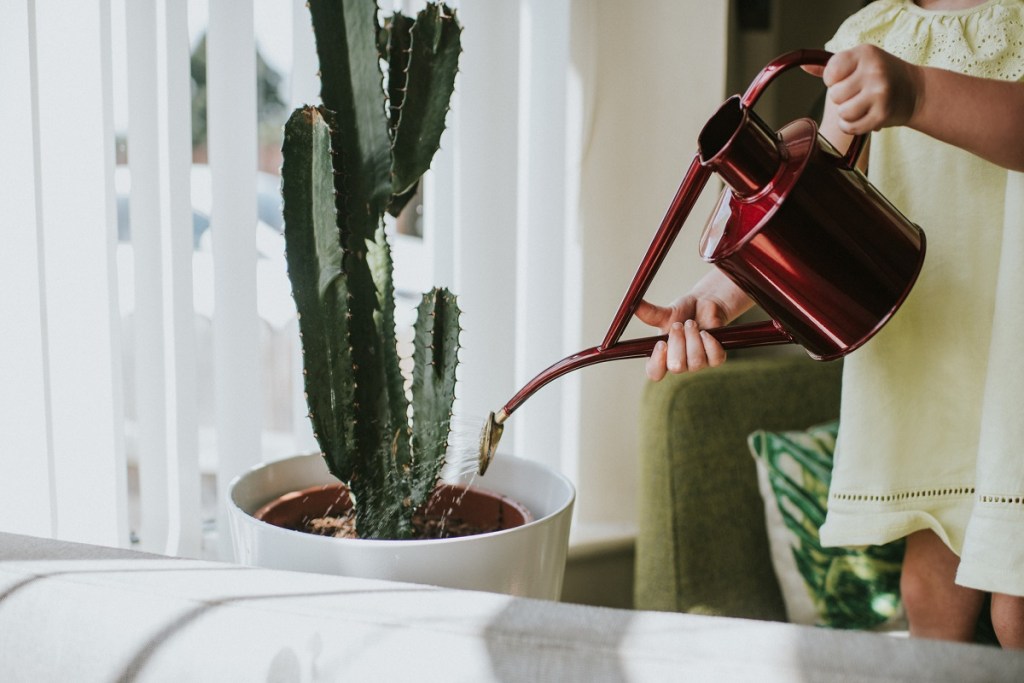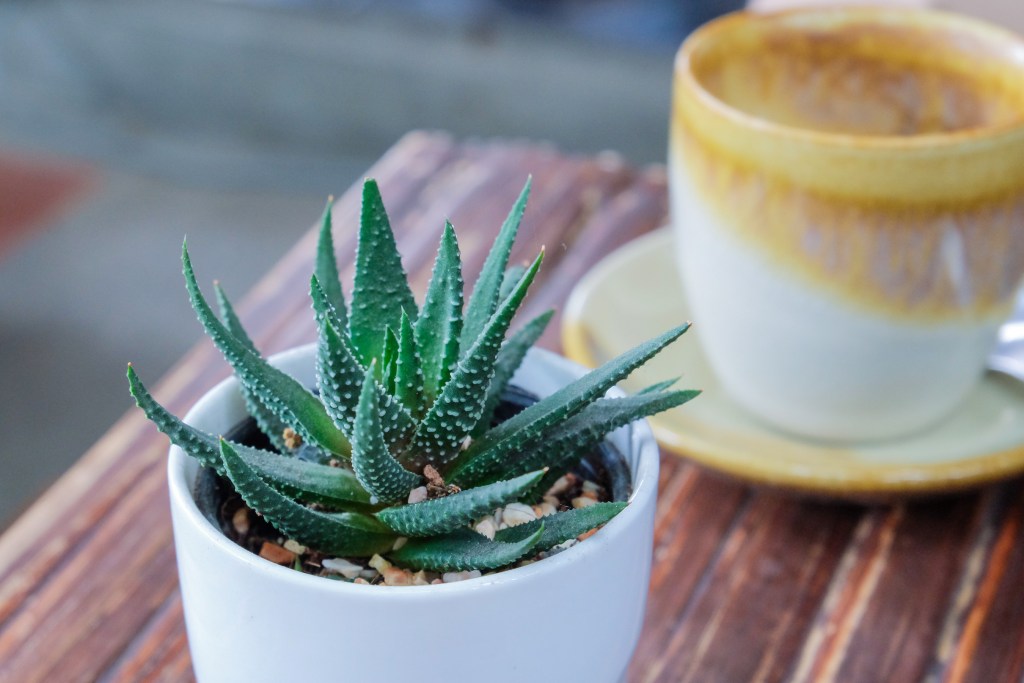Cacti may conjure images of giant prickly plants in the middle of the desert or memories of cartoon characters running into them and coming away with spines embedded all over. Some plant parents assume that because cacti are native desert plants, they never need water. Or, conversely, well-meaning plant parents accidentally grow their cacti by providing them with way more water than they can use. Either way, we're here to help set the record straight on these spiny succulents.
Actually, that's one thing we need to clear up right away: Cacti are succulents, but not all succulents are cacti. Although they have similar watering needs and requirements, cacti are plants of a specific family while the term “succulents” refers to plants from many different botanical families. Cacti are distinguished by their rounder shapes and spikes of varying sizes. If what you were calling a succulent (which wouldn’t be wrong) your plant that has thorns all over it, chances are it’s a cactus.
Now that we’ve got that out of the way, let’s talk about our thorny little friends. The houseplant varieties are small, hardy, and often regarded as great plants for beginners. Why? Because they can grow in a variety of spaces and don’t need the same amount of water as a regular houseplant. Even with that in mind, getting the hang of watering one can be a bit tricky.

What makes cacti difficult to water?
Even though cacti are pretty tough, their watering needs are different than that of other hardy houseplants like spider plants and pothos. Cacti don’t need to be watered as often, so if you aren’t used to caring for them, it can actually be pretty easy to overwater or underwater them.
It’s important to know their preferences — lack of familiarity is the most common cause both of drowning your plant and being overly cautious of watering to the point that it shrivels up.

How often should you water a cactus?
Improper watering is the most common cause of cacti downfalls, whether it’s too much or too little. Because cacti are native to desert areas and drier climates, they’ve adapted to store water over long periods of time and can retain moisture during periods of drought. They can only hold so much inside them, which is why overwatering can cause a lot of problems.
How often you water your cacti will depend a bit on the variety but mostly on the season, as far as frequency is concerned. The best way to know when your cactus needs water is to check the soil: If the top inch is dry, it’s time for a drink. For cacti, that means using the "soak and dry" method.
Step 1: Use the soak and dry method.
The soak and dry method involves watering the soil thoroughly until water starts to drip out of the drainage hole, then waiting until the mix dries almost completely before watering again. This method caters to the cactus's nature of storing water. If done well, this method will help the cactus survive a period of underwatering, should you need to travel or leave home (or if you just get busy and watering falls to the wayside, as happens to all of us now and again).
Step 2: Water during the growing season versus the inactive season.
Like with many houseplants, the season plays a role in the frequency of watering. It becomes increasingly important that you get used to checking the soil to see if your cacti are thirsty. Generally, the rule of thumb is that during the growing season, a healthy cactus will need to be watered every one to two weeks. During the inactive season, the schedule shifts to once every three to four weeks.
Step 3: No matter what your watering schedule is, check the soil.
This is important because not all cacti are the same, and not all indoor environments are the same. Because there are a lot of variables, the only way to be sure your cactus needs to be watered is by thoroughly inspecting the soil to see how dry it is.

Signs your cactus may be overwatered or underwatered
One of the best indicators of an overwatered or underwatered cactus is its appearance, which is why you should take time to familiarize yourself with how it looks. When it’s healthy, what’s the color like? How are the spines? What’s its shape?
Step 1: Check for visual signs of underwatering or overwatering.
An overwatered cactus will start to look limp and as if it’s about to fall over, which is due to the moisture content preventing it from retaining its shape. An underwatered cactus, on the other hand, will start to shrivel and look as if it’s aged. Its color will start to change, and you may even notice the spines are falling off because they’ve been weakened from a lack of nutrients.
Step 2: Check the soil for signs of overwatering.
The other factor to look at is the soil. If you’re not sure whether you’ve been watering too much or neglecting your plant, let the potting soil decide. Often with overwatered cacti, the potting mix is squishy, soggy, and may even have mold growing on top due to oversaturation. An underwatered cactus, on the other hand, will be sitting in bone-dry soil.
Step 3: Check the container for proper drainage.
Ideally, you want to pot your cactus in a container with a drainage hole and well-draining potting soil. If your pot doesn’t have proper drainage and you haven’t taken any steps to ensure that excess water has a place to go, then this may be the cause of your watering woes.
If you find yourself consistently overwatering your cactus and it's not in a container with proper drainage, that doesn’t mean you have to get rid of the pot completely. Take the plant out, dry off the roots, and clean and dry the pot. Add a small layer of pebbles or stones to the bottom of the pot. These rocks at the bottom will allow excess water to drain out of the soil and keep the roots from drowning. Then, repot your cactus as you usually would in fresh, clean cactus soil.

How to save your cactus from drowning and root rot
An overwatered cactus can be difficult to save if you didn’t catch the problem early enough. It's important to take action as soon as you confirm your plant is overwatered.
Step 1: Take the cactus out of its pot and discard the soggy soil.
Step 2: Inspect the roots for rot — they should be white, but any black, brown, or mushy parts indicate root rot.
If your cactus doesn’t have any white roots left, that means it’s too far gone. When there are white parts left, though, you have a chance to save it.
Step 3: Use clean, sterilized shears or scissors to cut away the rotting parts of the roots.
Sterilize the shears again once you’ve removed all the contaminated parts so that you don’t risk spreading disease to your other houseplants.
Step 4: Repot your cactus in fresh, dry potting mix and allow it to settle for about a week before you water again.
Step 5: When a cactus is underwatered, it can be tempting to give it a lot of water all at once to try to counter the problem; however, this can cause more harm than good.
Watering too much, even when the plant is underwatered, has the potential to cause the same problems as overwatering: root rot and drowning. The best thing you can do for an underwatered cactus is remain diligent. Follow all the above steps about paying close attention to determine when your cactus needs water and possibly fresh soil. Watering regularly (according to their needs) will help the plants stay happy and healthy.
Cacti can be surprisingly difficult to figure out, but thankfully, they're pretty easygoing once you figure out how much water they like. Just stay vigilant and always check the soil before watering. Don't bother with a schedule; your plant will tell you when it needs a drink, and as long as you pay attention to those cues, you and your prickly friend will live in harmony for years to come.
Editors' Recommendations
- Everything you need to know about trailing succulents care for lush, thick growth
- Stunning jade plant types to add to your succulent collection
- Your guide to rubber plant care and the best varieties to add to your home
- A mini cactus can be an adorable addition to any garden – here’s how to care for it
- Want to make your pothos plant’s vines thicker? Follow this guide



